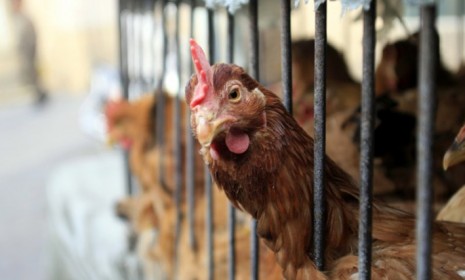The public release of H5N1 bird flu research: Too dangerous?
After six months of fierce debate, a controversial study outlining how the deadly virus could be engineered to transmit from human to human is finally published

After months of deliberation, a controversial study from the Netherlands closely examining how the H5N1 virus, or bird flu, could be genetically altered and transmitted by mammals as an airborne pathogen was published on June 21. The paper wasn't immediately disseminated upon its completion because of widespread concerns that bioterrorists could use the information to engineer a weapon against people. (A similar U.S. study had been published shortly before the Dutch paper became public.) Here, a concise guide to the ordeal:
What's in the paper?
The research, published in the journal Science, details how Netherlands-based researchers engineered H5N1 to transmit among ferrets, which respond to bird flu much like humans do. Typically, the bird flu can only move from bird to human; human to human transmission is rare. In the experiment, scientists took three flu virus mutations that caused worldwide pandemics in the years 1918, 1957, and 1968, and applied them to the modern bird flu.
The Week
Escape your echo chamber. Get the facts behind the news, plus analysis from multiple perspectives.

Sign up for The Week's Free Newsletters
From our morning news briefing to a weekly Good News Newsletter, get the best of The Week delivered directly to your inbox.
From our morning news briefing to a weekly Good News Newsletter, get the best of The Week delivered directly to your inbox.
What happened?
After scientists reinfected the ferrets multiple times, the virus was able to mutate enough to make it transmissible in the air. In other words, all it would take is a sneeze. Researchers believe this can be accomplished in as few as five mutations, although that number is admittedly "pretty difficult" to reach outside a laboratory. Such an outbreak, say researchers, could potentially kill 20 million to 150 million people worldwide.
Why publish the study if it's so dangerous?
In January, a U.S. biosecurity committee advised against the study's publication, while others said that the information should be closely guarded and limited to a select few. But scientists and health officials around the world argued that other susceptible countries could benefit from the study and learn how to fight the disease, which has killed nearly 60 percent of the 600 people known to have been infected since 2003. In February, the World Health Organization recommended that the U.S. and Dutch studies be published. In April, the National Institutes of Health complied. Supporters say that the scientific usefulness of the research "far outweighs the risk of nefarious" usage posed by potential terrorists.
A free daily email with the biggest news stories of the day – and the best features from TheWeek.com
Is there a cure for the virus?
It's "technologically possible," based on the genetic code of the H5N1 virus, to create a vaccine, says Elizabeth Landau at CNN, and several companies are already developing treatments. And now that research shows that it's possible for H5N1 to mutate and become airborne between non-birds, a cure could be crucial. "It is absolutely within the realm of possibility that they could evolve in a human host or some other mammalian host," says Derek Smith from the University of Cambridge, who co-authored a companion article on the virus for Science. "We see nothing — we see no fundamental hurdle to that happening." The issue, now, is determining whether the risk of an outbreak happening "is 1 in 1,000 or whether it's 1 in 100 million."
Sources: AFP, CNN, USA Today, Wall Street Journal
-
 Political cartoons for January 3
Political cartoons for January 3Cartoons Saturday's political cartoons include citizen journalists, self-reflective AI, and Donald Trump's transparency
-
 Into the Woods: a ‘hypnotic’ production
Into the Woods: a ‘hypnotic’ productionThe Week Recommends Jordan Fein’s revival of the much-loved Stephen Sondheim musical is ‘sharp, propulsive and often very funny’
-
 ‘Let 2026 be a year of reckoning’
‘Let 2026 be a year of reckoning’Instant Opinion Opinion, comment and editorials of the day